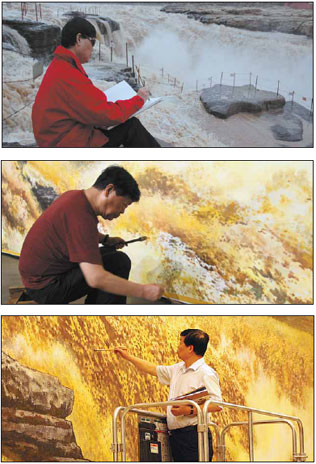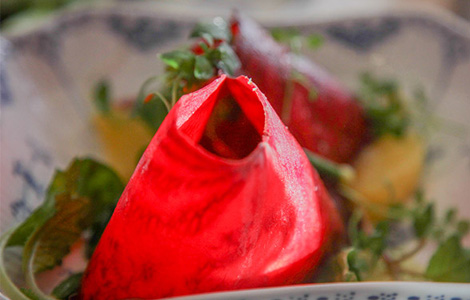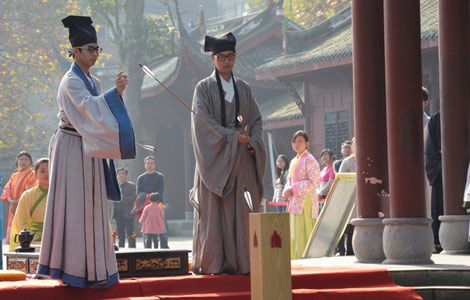Mural brings raging waters of Yellow River to Great Hall
Updated: 2013-11-17 07:04
By Hao Nan (China Daily)
|
|||||||||||
Full of vigor and raw emotion, the paintings of Wang Xijing are representative of the artistic styles of Shaanxi, critics say.
The master of Chinese painting was invited by the managing bureau of the Great Hall of the People in Beijing to produce a massive oil painting depicting the Yellow River, known as the mother river in China.
The landscape painting titled Yellow River / The Mother River completed in nine months depicts a magnificent scene of Hukou waterfall, part of the Yellow River.
The work is so lifelike that it looks as if the surging waves are ready to spurt forth from the picture frame.
"The Great Hall of the People hosts many important Chinese and international events to show the national image, so it is a great honor to have my painting hung on a wall of the grand building," Wang said.
One of Wang's favorite subjects, the Yellow River holds a special place in the artist's heart. He grew up in the city of Lintong, which is very close to the river's largest branch, the Weihe River.
The 67-square-meter painting has impressed many of the artist's peers and critics of Chinese contemporary art.
Shao Dazhen, art theorist and professor of Central Institute of Fine Arts.
This painting can be considered a milestone in Wang's artistic creation. It blends well with the solemn atmosphere that prevails in the central hall of the Great Hall of the People, bringing a strong and distinct artistic appeal to visitors.
Li Shusheng, professor of Central Institute of Fine Arts.
Choosing the Hukou waterfall to show the splendor of the Yellow River demonstrates his deliberation, because I think the waterfall is the most representative part of the river. The water he painted is surging forward with great momentum, which is in line with the spirit of our time.
Lu Yushun, vice-president of China National Academy of Painting.
Wang is one of the most acclaimed artists of Chinese contemporary art. His early works and this Yellow River-themed landscape painting all stand in the forefront of the times in the field of mainstream art. His works embody the esteem and confidence to the Chinese culture and spirit.
Xu Hong, senior researcher of the China National Art Museum.
Wang has drawn an overpowering picture. It has added some sense of musicality and fluidity to the central hall, which is filled with rigid structure. This piece is a typical landscape painting that is suited to aesthetic modernity.
Chen Zui, researcher of Chinese National Academy of Arts.
The Yellow River is a unique concept and a meaningful symbol in Chinese culture. Any literature, music and painting will easily bring artistic appeals to Chinese viewers if they have similar elements. This painting is very touching and amazing due to his endeavor in combining his artistic skills, understanding of the spirit as well as perseverance and tenacity.
Wang Zhichun, researcher of Beijing Fine Art Academy.
The painting and the central hall are complementary to each other. The sense of power is an outstanding feature of the painting, which is partly caused by the contrast of color. With rich symbolic and spirit connotation, the work is a masterpiece of Wang that reflects his achievements in the past and new exploration in the future.
Zheng Gong, deputy director of Institute of Fine Arts, Chinese National Academy of Arts.
In many traditional landscape paintings, mountains are usually painted as the main focus and water serves as background or plays a subsidiary role. This painting is just on the contrary by making water as the main subject to present its power and vigor as well as independence and tolerance. I think it is very successful.
Zhao Lizhong, member of China National Academy of Painting.
There are many paintings using the Hukou waterfall to represent the Yellow River, but most have nothing else to offer besides of the waterfall's shape and appearance. Wang's work is different and it has depicted some details which leaves space for imagination.
Xia Shuoqi, then-chief editor of Art Magazine.
This Yellow River-themed painting highlights the harmony of various contrasted elements. Wang has shown the spirit and nature of things by carefully observing the subject he wants to show and then expressing its most distinct characteristics.
Cheng Zheng, professor at Xi'an Fine Art College.
Wang and I were classmates in college, and I knew his efforts to become a good painter. Now, he also shoulders many social positions such as a National People's Congress representative and the chairman of Shaanxi Provincial Association of Artists, so he is more than just being a painter, with broadened horizons and bigger goals.
Liang Jiang, vice-president of China National Art Museum.
It is a challenge for artists to create a painting for the Great Hall of the People because it must be consistent with the building's solemn and immense style.
The suitable paintings should be able to reflect the spirit of the times and also in line with the modern aesthetic sensibilities.
Wang's work captures the notion of national rejuvenation and the pursuit of the "Chinese dream" by depicting the boldness and splendor of the great Mother River.
haonan@chinadaily.com.cn
|
More than fame and success, the art world offers Wang Xijing a liberating place full of possibilities and challenges. Photos Provided to China Daily |
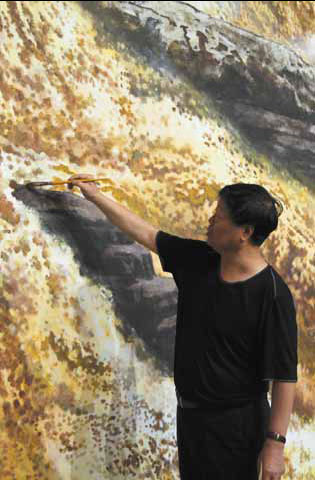 |
|
Wang Xijing spent nine months producing this massive work. The pictures above show some of the process and the forum on the painting in the Great Hall of the People in Beijing. |


(China Daily 11/17/2013 page4)
Today's Top News
President Xi meets Dutch PM, pledging further ties
China ready to send rescue teams to Philippines
Wait a minute, baby
Map unveiled for profound reform
Typhoon death toll tops 3,621
Chinese market to open wider
Deepened reform will help tighten Sino-US links: Xi
China to ease family planning policy
Hot Topics
Lunar probe , China growth forecasts, Emission rules get tougher, China seen through 'colored lens', International board,
Editor's Picks

|

|

|

|
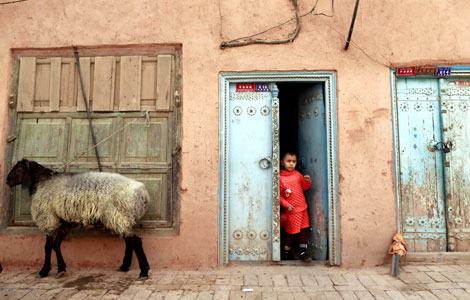
|

|

